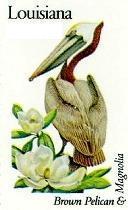
Brown Pelican
(Pelecanus occidentalis)
Adopted on July 27, 1966.
The brown pelican became Louisiana's official bird on July 27, 1966. It nests from South Carolina to Brazil. Pelicans are famous for their large bill, the lower portion of which has a pouch which may be greatly extended.
The pelican is featured on Louisiana's flag and state seal, and one of Louisiana's nicknames is "The Pelican State." This bird has been a symbol of Louisiana since the arrival of early European settlers who were impressed with the Pelican's generous and nurturing attitude toward their young.
The birds, depending almost entirely on fish for food, scoop up quantities of water into their pouches as they seize prey from salt water. As the bill is elevated the water dribbles from the mandibles, and the pouch contracts as fish are swallowed. Five pounds of fish a day is the average consumption of a one-month old pelican.
The use of pesticides caused the Brown Pelican, native to the area, to stop nesting along the Gulf coast in the 1960s. By 1966, the bird had disappeared in Louisiana. In 1968, Louisiana began importing fledglings from Florida in an attempt to repopulate the coastline and, in 1970, the Federal Government declared the Brown Pelican an endangered species. Protection of the Brown Pelican's habitat along with repopulation efforts resulted in the Federal Government's declaration, in 1995, that the bird had "recovered" in Louisiana.
Identification
- Length: 41 inches Wingspan: 90 inches
- Sexes similar
- Huge, dark bird
- Long bill with a pouch, dark on Atlantic/Gulf coasts; bill paler along Pacific coast, becomes yellow during breeding season
- Flies with neck tucked
- Plunges from great heights into water to catch fish
Adult alternate:
- White foreneck and head with yellow crown
- Chestnut neck and nape
- Gray-brown body plumage with slightly darker flight feathers
Adult basic
- Yellowish crown
- White head and neck
- Gray-brown body plumage with slightly darker flight feathers
Immature:
- Dark brown overall, gradually acquiring adult plumage over three years
|
|
| Kingdom |
Animalia -- animals |
| Phylum |
Chordata -- chordates |
| Subphylum |
Vertebrata -- vertebrates |
| Class |
Aves -- birds |
| Order |
Ciconiiformes -- albatrosses, alcids, auks, cormorants, diurnal birds of prey, eagles, falconiforms, falcons, flamingos, grebes, gulls, hawks, herons, ibises, loons, osprey, oystercatchers, pelicans, penguins, petrels, plovers, shearwaters, shore birds, storks, totipalmate swimmers, tube-nosed swimmers |
| Family |
Pelecanidae -- pelicans |
| Genus |
Pelecanus Linnaeus, 1758 -- pelicans |
| Species |
Pelecanus occidentalis Linnaeus, 1766 -- brown pelican, Pelícano pardo |